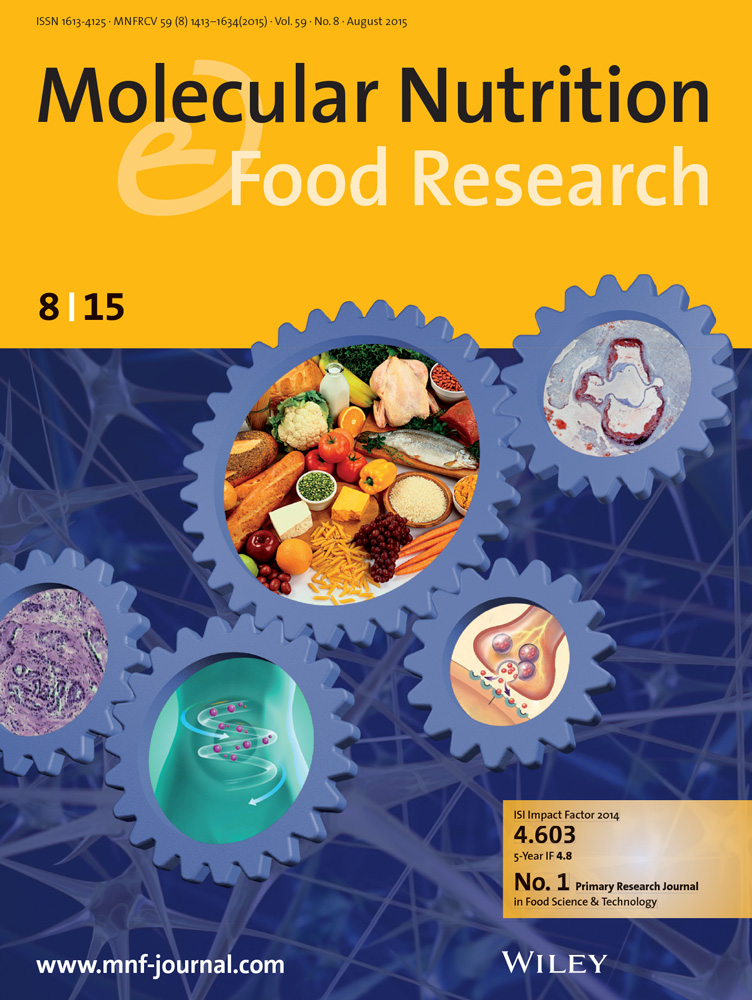蛋白质组学分析揭示了蔓越莓原花青素抑制食管腺癌的机制。
IF 4.5
2区 农林科学
Q1 FOOD SCIENCE & TECHNOLOGY
引用次数: 0
摘要
蔓越莓原花青素(CPACs)在人体中具有有效的抗炎和抗菌活性,并在临床前模型中具有抗癌作用,包括针对食管腺癌(EAC)的模型。本研究应用蛋白质组学分析研究了CPACs对大鼠模型返流诱导的EAC的抑制作用。串联质谱法应用于从水、CPAC和反流暴露的食管中分离的蛋白质,CPAC治疗和不治疗。鉴定了差异表达蛋白,随后进行富集分析,以评估CPACs改善回流诱导的基因集标志、途径和过程网络变化的能力。CPAC直接逆转42.1%的反流诱导蛋白改变。基因集富集分析(GSEA)显示,CPAC减轻了回流诱导的EAC中富集的11个标志(即氧化磷酸化、肌生成、脂肪生成、MYC靶点和P53)。被反流过度代表并被CPAC直接逆转的顶级途径包括剪接体、代谢途径和IL-17信号。转录_mrna加工、翻译调控/起始和炎症(即小钾likrein-kinin系统、中性粒细胞激活)主导了由反流上调和CPAC下调的过程网络。仅被反流改变而不被CPAC缓解的网络包括核糖体连锁翻译、免疫反应抗原呈递和瘦素信号传导。同样,CPAC并没有逆转与回流相关的泛素代谢下调。确定CPAC无法缓解的反流诱导的癌症过程和途径,可能为今后联合预防工作提供机会。本文章由计算机程序翻译,如有差异,请以英文原文为准。
Proteomic Profiling Informs Mechanisms of Esophageal Adenocarcinoma Inhibition by Cranberry Proanthocyanidins.
Cranberry proanthocyanidins (CPACs) exert potent antiinflammatory and antibacterial activities in humans and anticancer effects in preclinical models, including those targeting esophageal adenocarcinoma (EAC). This study applied proteomic profiling to investigate CPACs' inhibitory effects on reflux-induced EAC in a rat model. Tandem mass spectrometry was applied to protein isolated from water-, CPAC-, and reflux-exposed esophagi with and without CPAC treatment. Differentially expressed proteins were identified, followed by enrichment analyses to assess CPACs' capacity to ameliorate reflux-induced changes in gene set hallmarks, pathways, and process networks. CPAC directly reversed 42.1% of reflux-induced protein alterations. Gene set enrichment analysis (GSEA) revealed CPAC mitigated 11 hallmarks enriched in reflux-induced EAC (i.e., oxidative phosphorylation, myogenesis, adipogenesis, MYC targets, and P53). Top pathways over-represented with reflux and directly reversed by CPAC included spliceosome, metabolic pathways, and IL-17 signaling. Transcription_mRNA processing, translation_regulation/initiation, and inflammation (i.e., kallikrein-kinin system, neutrophil activation) dominated process networks upregulated by reflux and downregulated by CPAC. Networks exclusively altered by reflux and not mitigated by CPAC included ribosomal-linked translation, immune response_antigen presentation, and leptin signaling. Similarly, CPAC did not reverse the reflux-linked downregulation of ubiquinone metabolism. Identifying reflux-induced cancer processes and pathways that CPAC fails to mitigate may inform opportunities for combination prevention efforts moving forward.
求助全文
通过发布文献求助,成功后即可免费获取论文全文。
去求助
来源期刊

Molecular Nutrition & Food Research
工程技术-食品科技
CiteScore
8.70
自引率
1.90%
发文量
250
审稿时长
1.7 months
期刊介绍:
Molecular Nutrition & Food Research is a primary research journal devoted to health, safety and all aspects of molecular nutrition such as nutritional biochemistry, nutrigenomics and metabolomics aiming to link the information arising from related disciplines:
Bioactivity: Nutritional and medical effects of food constituents including bioavailability and kinetics.
Immunology: Understanding the interactions of food and the immune system.
Microbiology: Food spoilage, food pathogens, chemical and physical approaches of fermented foods and novel microbial processes.
Chemistry: Isolation and analysis of bioactive food ingredients while considering environmental aspects.
 求助内容:
求助内容: 应助结果提醒方式:
应助结果提醒方式:


